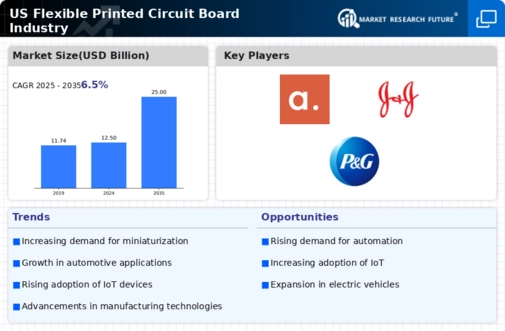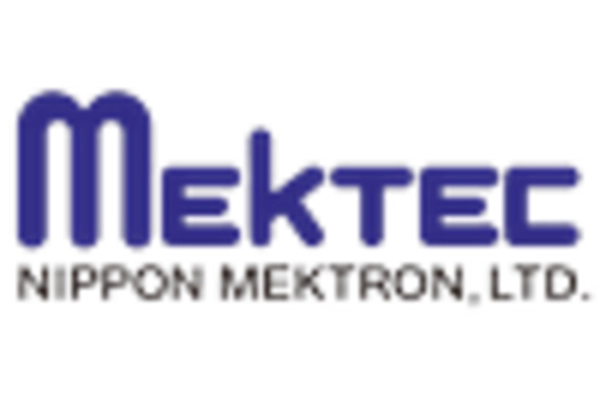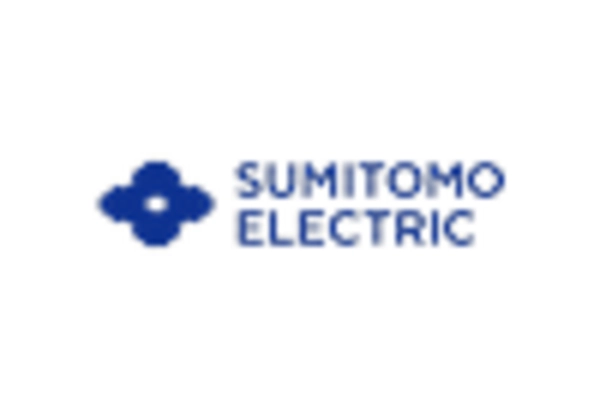Increased Focus on IoT Devices
The flexible printed-circuit-board market is significantly impacted by the growing emphasis on the Internet of Things (IoT) devices. As industries increasingly adopt IoT solutions for automation and data collection, the demand for flexible printed-circuit-boards rises due to their ability to facilitate connectivity in compact designs. In 2025, the IoT market is projected to exceed $1 trillion, with flexible circuits being integral to the functionality of smart devices and sensors. The lightweight and flexible nature of these circuits allows for innovative applications across various sectors, including agriculture, manufacturing, and smart homes. Thus, the flexible printed-circuit-board market is well-positioned to thrive as it aligns with the expanding IoT ecosystem.
Growth in Automotive Electronics
The automotive sector significantly influences the flexible printed-circuit-board market, as vehicles increasingly incorporate advanced electronic systems. The integration of features such as infotainment systems, advanced driver-assistance systems (ADAS), and electric vehicle (EV) technologies necessitates the use of flexible printed-circuit-boards. In 2025, the automotive electronics market is expected to reach $300 billion, with flexible circuits playing a crucial role in enhancing vehicle performance and safety. The lightweight nature of flexible printed-circuit-boards contributes to improved fuel efficiency and reduced emissions, aligning with the industry's shift towards sustainability. Consequently, the flexible printed-circuit-board market is likely to benefit from the growing demand for innovative automotive solutions, positioning itself as a key player in the evolving automotive landscape.
Rising Demand for Consumer Electronics
The flexible printed-circuit-board market experiences a notable surge in demand driven by the increasing consumption of consumer electronics. As devices such as smartphones, tablets, and wearables become more prevalent, the need for compact and lightweight circuit solutions intensifies. In 2025, the consumer electronics sector is projected to account for approximately 35% of the overall market share. This trend indicates a shift towards miniaturization, where flexible printed-circuit-boards offer the necessary adaptability and space-saving features. Furthermore, advancements in technology enable manufacturers to produce more efficient and reliable flexible circuits, further propelling their adoption in consumer electronics. The flexible printed-circuit-board market is thus poised for growth as manufacturers strive to meet the evolving demands of tech-savvy consumers.
Expansion of Medical Device Applications
The flexible printed-circuit-board market is witnessing a significant expansion due to the increasing utilization of flexible circuits in medical devices. As healthcare technology advances, there is a rising demand for compact, reliable, and flexible solutions that can be integrated into various medical applications. In 2025, the medical device market is projected to surpass $500 billion, with flexible printed-circuit-boards being essential for devices such as portable diagnostic equipment and wearable health monitors. These circuits enable enhanced functionality while maintaining a lightweight profile, which is crucial for patient comfort and usability. The flexible printed-circuit-board market is thus positioned to capitalize on this trend, as manufacturers innovate to meet the stringent requirements of the healthcare sector.
Telecommunications Infrastructure Development
The flexible printed-circuit-board market benefits from the ongoing development of telecommunications infrastructure, particularly with the rollout of 5G technology. As telecommunications companies invest heavily in upgrading their networks, the demand for advanced electronic components, including flexible printed-circuit-boards, is expected to rise. In 2025, the telecommunications market is anticipated to reach $1 trillion, with flexible circuits playing a vital role in enhancing signal quality and reducing interference. The adaptability of flexible printed-circuit-boards allows for innovative designs that can accommodate the complex requirements of modern communication systems. Consequently, the flexible printed-circuit-board market is likely to experience growth as it supports the expansion of next-generation telecommunications.
















Leave a Comment